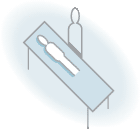- Case History
- Nursing Records
- Results
- Investigations
- Prescription Sheets
- Correspondence
Questions
1. Discuss whether you should have taken a capillary or an arterial gas.
Cap gases are certainly more popular in paediatric practice but are particulary prone to error if there is poor peripheral circulation as there appears to be in this case. A much more accurate result is likely if an arterial sample is taken.
2. What does the ABG show?
Metabolic acidosis with partial respiratory compensation. Our gas machine also gives some electrolyte information which shows signicantly raised levels of sodium and chloride.
3. What is the anion gap?
Na+K-HCO3+Cl
In this case it is markedly raised at 26.3
Normal is 12-16
4. Why is the anion gap so high?
Well, certainly the lactate will raise the anion gap but at 6mmol/L it would not account for a gap of 26.3 and something else must be contributing to this. With the clinical picture suggesting dehydration then Renal impairment/dehydration is the most likely candidate, and indeed her Urea was 19.3
5. What is the strong ion gap?
Well, the standard anion gap only takes account of the 4 elements shown above, yet there are clearly many more substances that can affect it. The strong ion gap is a more in depth method that measures and calculates the ion gap taking into account the following factors
Sodium
Potassium
Magnesium
Calcium
Chloride
Lactate
Urate
it is most useful if you find a large anion gap which you cannot account for in terms of initial standard biochemical tests. If the SIG answers your question then fine, you know what to deal with. If not then you must think what else might be going on (e.g. poisoning from unmeasured ions). It is pretty complex to calculate so I won't here :-) but if you want to know more try http://www.anaesthetist.com/icu/elec/ionz/


